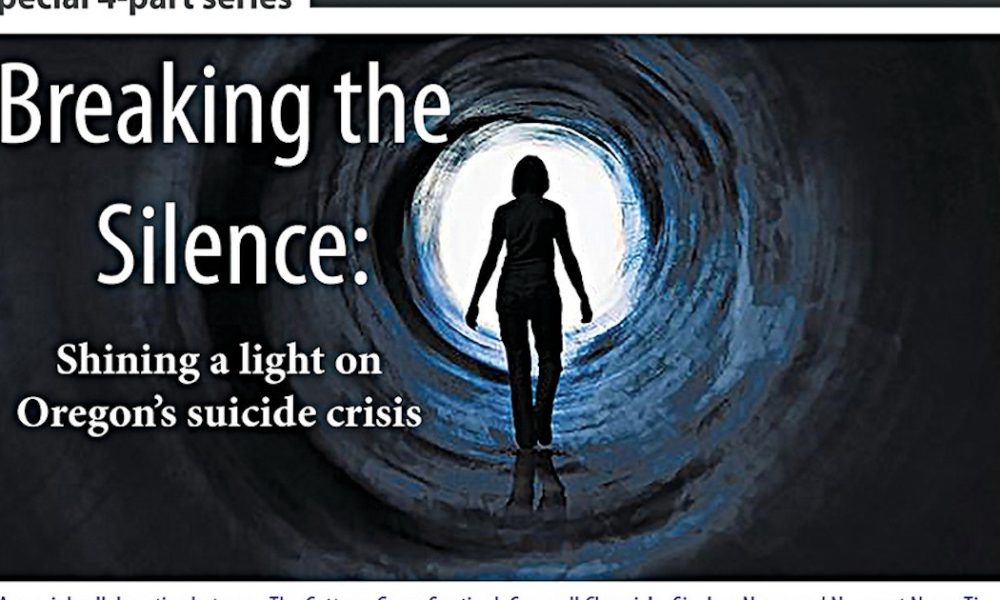
Editor’s note: This is the third in a four-part special collaboration between The Creswell Chronicle, the Cottage Grove Sentinel, Siuslaw News and Newport News-Times. Each week in April, these newspapers will contribute a part about Oregon’s suicide crisis to the series.
Suicide by veterans is a major problem across America and in Oregon, and it is a problem that, according to recent statistics, is getting worse.
Suicide among soldiers was a topic of conversation last week among Florence-area veterans, spurred primarily by the visit of the traveling replica of the Vietnam Veterans Memorial Wall, ”The Wall That Heals.”
Underscoring the memorial’s visit was the unexpected death of local veteran Pete Maury, who took his life just days before the wall’s arrival. The night before, Maury and his wife, Bev, had spent the evening with a group of friends enjoying dinner at Elks Lodge No. 1858. Later that evening after returning home, Maury ended his life with a single gunshot.
When ”The Wall That Heals” arrived a few days later, Maury’s fellow veterans were mourning his loss and agreed to speak with The Siuslaw News in an honest discussion about the possible reasons for their friend’s suicide. Most were in agreement that the physical pain he was enduring, coupled with the inevitable decline in his quality of life, led him to suicide.
Jerry Hernandez is the commander of Disabled American Veterans Chapter 23, and a strong advocate for the needs of the local veterans’ community.
”With Pete Maury for example, you get to a certain age and all those injuries you got during the war or during your service time – they start to get more intense,” Hernandez said. ”The pain gets more intense and Pete was tired of the pain. It had been going on for so long, he was just tired of the pain.”
Maury had operations on his knees and his legs, and it was just going on for too long, he said.
”About five years ago, a friend of his passed away, the same way, committing suicide. So this was on Pete’s mind, too,” Hernandez said. ”If you were in the military and you had friends that committed suicide, sometimes it’s contagious.”
Maury was a longtime member of the Elks and his work with the Florence Municipal Airport Volunteers was well known and appreciated, greeting visiting pilots and travelers as recently as three weeks ago.
According to his wife and friends, there was no indication from Maury’s behavior or words that would have indicated he had plans of suicide later that evening. He seemingly enjoyed his last night, chatting with friends during his meal and even making an attempt at dancing which, with his limited mobility, was not an easy task.
But after Maury and his wife returned home, he went to the garage and took his life.
”I think Pete just wanted it that way,” Hernandez said. ”He didn’t want anybody to know what he was planning. He had been thinking about it for some time. He had mentioned it one time and we all said, ‘He’s not going to do that.’ ”
The average rate for veteran suicides is more than 6,500 a year. Each day, approximately 20 veterans kill themselves. Most of these deaths are by gunshot. Rick Shore is the treasurer for Disabled American Veterans and he said the reason guns are used in most veteran suicides is a simple one.
”They are a tool we were trained to utilize, and we have them because of that,” he said. ”That makes them easily accessible and we are not afraid to use them. Unfortunately, we are using them on ourselves,” Shore added, a tremor in his voice.
The fact is, there has always been concern that those who serve in combat are at greater risk of depression and alienation when returning to civilian life. Those concerns have been voiced by family members and the loved ones of veterans, going back to the Revolutionary War. There is also anecdotal evidence dating back to World War I that indicates suicide among veterans was an issue of public concern for a number of years after that war.
Reports of World War II and Korean War veterans dying by suicide were often not publicized or misidentified as ”accidental.” As a result, accurate statistical information on suicide rates among this group of veterans has been limited.
According to the Department of Veterans Affairs, the suicide rate for veterans in Oregon in 2016 – the most recent year for which data is available -increased 25.9 percent between 2005 and 2016. And overall, rates of suicide have been increasing for both men and women – across all age groups – in the United States for the past 20 years.
According to a recent Center for Disease Control report, the age-adjusted rate of suicide increased by 24 percent between 1999 and 2014. Findings from this same report show that increases in rates of suicide were higher between 2006 and ’14 than earlier dates.
The uncertainty surrounding veteran suicide has been clarified to a certain degree with the release of what is the first comprehensive nationwide study ever made regarding suicide among the veteran community.
The numbers and the conclusions they indicate are unsettling at best, with the most recent data available for Oregon (2016) showing that 744 people committed suicide that year – and of those deaths, 122 were veterans; 112 male and 10 females.
Or put another way, 39 percent of suicides in Oregon during 2016 were veterans.
The high public profile of veterans returning from wars in Afghanistan and elsewhere in the Middle East has forced the military to be considerably more proactive in its approach to dealing with what might be termed an epidemic.
It wasn’t until an alarming number of younger, active-duty service members started to die by their own hand that the Department of Veterans Affairs undertook a series of studies to assess the problem of military-related suicide. These studies compile statistics from a wide array of locations and age groups for a better overview of the growing problem.
Among the most troubling trends revealed by the study was that 23 veterans took their lives while on the grounds of their local VA hospitals, usually in the hospital’s parking lot. Just last week, two veterans committed suicide at VA facilities in Georgia and one at a facility in Florida.
The men had previously complained about the treatment they had received from the VA and mentioned those experiences as one of the reasons for their deadly actions.
The military has attempted to make counseling services and support more available to vets and the money allocated for these services has increased dramatically during the ongoing wars in Afghanistan and Iraq. These efforts have met an increasing tide of servicemen and women suffering from Post-Traumatic Stress Disorder (PTSD) in addition to serious brain injuries and the effects of being deployed to a war zone on multiple occasions.
There has also been an apparent disconnect between the policy of promoting education and connecting with vets and its implementation.
The VA had a 2017 budget of $6.5 million for public outreach and education yet used only $57,000 of the money allocated for that purpose.
”A lot of people in the public think the problem is financial, but there is money literally sitting there that is supposed to be used for suicide prevention and it is not being used,” Shore said.
The VA published a comprehensive report in 2016 which analyzed records from 55 million veterans whom had served in the military between 1979 and 2014. The data, unlike previous studies, was collected from all 50 states and from health-service sources whose primary affiliation was not with VA hospitals.
The analysis confirmed that approximately 20 veterans commit suicide every day – one every 65 minutes.
These successful suicides are only one third of the estimated attempts on any given day.
The report concludes: Approximately 65 percent of all veterans who died from suicide in 2014 were 50 years of age or older.
Since 2001, U.S. adult civilian suicides increased 23 percent, while veteran suicides increased 32 percent in the same period. After factoring for age and gender, this makes the risk of suicide 21 percent greater for veterans.
Since 2001, the rate of suicide among U.S. veterans who use VA services increased by 8.8 percent, while the rate of suicide among veterans who do not use VA services increased by 38.6 percent.
In the same period, the rate of suicide among male veterans who use VA services increased 11 percent, while the rate of suicide increased 35 percent among male veterans who do not use VA services.
In the same period, the rate of suicide among female veterans who use VA services increased 4.6 percent while the rate of suicide increased 98 percent among female veterans who do not use VA services.
The issue of veteran suicide is tied directly to the need for improved assessment and treatment of mental health-based problems suffered by veterans. The numbers supplied by the VA point out the connection between reduced rates of suicide and treatment at a VA facility.
On the other side of that discussion is the view held by some veterans that the VA is not operating in the best interests of the veteran community by not providing additional Veterans Service Officers (VSOs) to assist with veteran issues.
”With the VSOs, there is a feeling that at least somebody cares. The VSOs care enough to come here and do the paperwork and help them learn the system. The system is very difficult, and they don’t know what to expect,” Shore said.
Steve Baggins is the Adjutant for the DAV and he said the need for more staff, especially physicians, to deal with the increasing number of veterans filing claims is essential to stemming the problem of veteran suicide.
”Besides the lack of administrative staff, they are also having problems getting doctors and keeping them. They work in the system for one or two years and then they go into private practice,” Baggins said.
Congressman Peter DeFazio represents Oregon’s 4th District and has been an advocate for increased funding for the VA and has also been at the forefront of calling for leadership changes at VA facilities in the state.
In May of 2018, DeFazio testified before the House Committee on Veterans Affairs calling for serious reform in the management of the Roseburg VA hospital.
The Veteran’s Integrated Health Networks (VISN) was the specific target of DeFazio’s concern.
”If VISNs cannot function at a high level and competently fulfill their duty to perform meaningful oversight, I recommend the abolishment of the VISN structure and the establishment of a stronger oversight authority. Our veterans deserve better,” DeFazio said.
In response to DeFazio’s pressure on then-VA Department Secretary David Shulkin, the VA’s Office of the Medical Inspector and Office of Accountability and Whistleblower Protection found evidence of serious problems with employee management and intimidation, medical care and inadequate resources. As a result, the VA made a number of recommendations in order to address these problems and make overall improvements to VA Medical Centers around the country. Every day, more than 400 VA Suicide Prevention Coordinators and their teams, located at every VA medical center, connect veterans with care and work towards educating the community about suicide prevention programs and resources.
If you or someone you know is experiencing depression or talks about suicide the Veterans Crisis Line is available 24 hours a day, seven days a week at 1-800-273-8255. In addition to the Veterans Crisis Line, the VA offers a network of support and mental health resources for all veterans and their families and friends. There are also walk-in veteran outpatient clinics in Eugene, Newport and North Bend that will see clients without an appointment.







